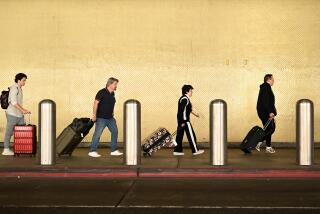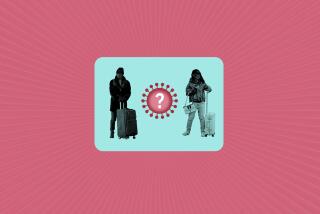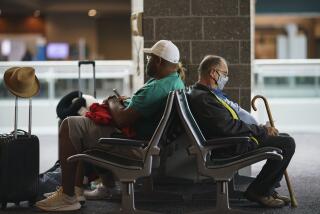Avoiding Tooth Traumas
- Share via
Dental problems can sneak up on any traveler, playing havoc with dream vacations and business trips. But following a few simple guidelines and packing a few first-aid items can minimize both risk and pain.
Travelers scheduled for root canal treatment, which can require two visits spaced four to seven days apart, should complete it before air travel, said Jack Brown, a Beverly Hills endodontist.
Traveling by plane in mid-treatment can cause toothaches, Brown said. Exactly why has not been scientifically studied, but Brown speculates that atmospheric gases within a root canal that has been emptied of its pulp but is not yet packed with permanent filling material may expand within the space, applying pressure to nerves around the tooth.
“We try to finish treatment before travel,” Brown said. When that’s impossible, he tells patients what to expect: “The pain is usually brief, and it will usually pass quickly,” he said. Taking along pain-relieving medication is a good idea, he also tells patients.
Patients in the midst of root canal treatment should also avoid scuba diving, said Martin Rotman, a West Los Angeles dentist who has heard complaints of pain from his patients who have attempted the sport.
Patients who have undergone gum surgery or extraction should inform their dentist about upcoming travel plans. It might be wise, Rotman said, to allow for a bit of observation time after such procedures, to rule out complications such as bleeding or infection. “And it wouldn’t be a bad idea to take some antibiotics along,” Rotman said.
Packing over-the-counter remedies can help. Brown recommends taking along temporary preparations, available over the counter for about $5, that can be used to reattach a dislodged filling or crown. The user mixes a powder and liquid provided in the kit, rolls it into a small ball and presses it into the area to be filled. To replace dislodged crowns, the user puts a small amount of the mixture on the inside edge of the crown before gently replacing it. The kit is designed only for temporary relief.
Travelers who have not packed such preparations could use a thin layer of petroleum jelly to replace a dislodged crown, said Steven Goldy, a Beverly Hills dentist. “Use a sharp pin to remove the old cement,” he said. “Clean off the tooth and dry it.” Put a thin layer of petroleum jelly on the side of the crown and gently replace it.
Orthodontic patients should stow some orthodontic wax, which can be spread over rough edges if a wire breaks, experts said.
Travelers with a history of periodontic problems should take plenty of floss to prevent tiny pieces of food from lodging in the teeth, prompting severe gum inflammation. A saline cleanser, available in drugstores, can soothe irritated gums temporarily. But warm saltwater, readily available by just sprinkling table salt in water, probably works just as well, Rotman said. Hydrogen peroxide and water, mixed half and half, can also help, Goldy said.
Also worth packing: a mouth mirror (sold over-the-counter at many pharmacies), denture repair kits, cotton balls to swab areas to be filled, tweezers, mouthwash, toothache remedies and over-the-counter pain relievers.
Certain do-it-yourself treatments do more harm than good, dental experts concur. When toothache strikes, applying aspirin directly to the gum is a popular but misguided remedy, because it can cause a chemical burn. “It will complicate the problem,” Rotman said. “You will then have the toothache and a burn on your gums.”
If a tooth is knocked out, “clean it gently to get rid of debris and dirt,” Goldy said. Keep the tooth moist, either by reinserting it or putting it in a wet paper towel, experts suggest. “Get to a dentist within the hour,” Goldy said.
Even knocked-out baby teeth should be checked by a dentist, Rotman said, to make sure part of the tooth does not remain under the gum line.
In Goldy’s experience, knocked out teeth are not that common. Broken teeth are more typical. “If you have a broken tooth, get to a dentist as soon as possible.” Saving the broken portion can’t hurt, he added. Seeing it can help the dentist evaluate the break and decide the best treatment.
To find a dentist while traveling, ask the hotel concierge for possible referrals. If traveling in the United States, look up the state dental society in the phone book and call. Overseas, seek out a dentist affiliated with a local university, experts suggested.
Before consulting the out-of-town dentist, a long-distance call to one’s own dentist is probably a wise investment, Rotman said. A traveler’s dentist can probably provide important details for the emergency dentist--or even talk directly to the colleague and share essential patient history.
The Healthy Traveler appears the second and fourth week of every month.
More to Read
Sign up for The Wild
We’ll help you find the best places to hike, bike and run, as well as the perfect silent spots for meditation and yoga.
You may occasionally receive promotional content from the Los Angeles Times.






